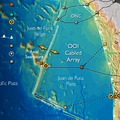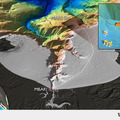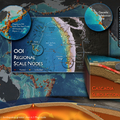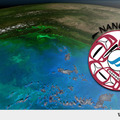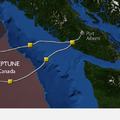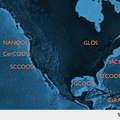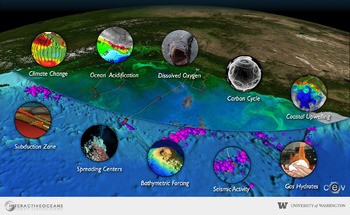Ocean Observing in the NE Pacific
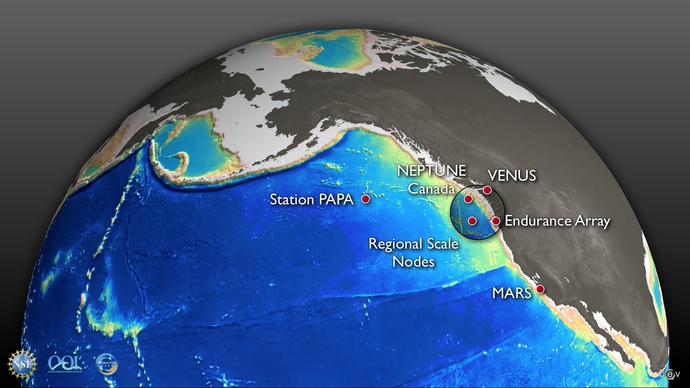
A representative suite of natural phenomena occurring in the Northeast Pacific Ocean are found throughout the world's oceans and seafloors.
The U.S. Cabled Array Fiber-Optic Ocean Observatory
The University of Washington lead the design, construction, and installation of the NSF Ocean Observatories Initiative's Regional Cabled Array, the first U.S. plate scale cabled ocean observatory. This novel cabled ocean observatory includes 900 kilometers of cable that stretches across the Juan de Fuca tectonic plate, running from a shore station in Pacific City, Oregon, out to the Juan de Fuca Ridge and south along the Cascadia subduction zone to Hydrate Ridge. Eighteen nodes densely populated with instruments and full water column moorings are installed at study sites at Hydrate Ridge, Axial Volcano, and at shallow coastal sites west of Newport Oregon. High bandwidth data and video imagery is now being transmitted from >100 instruments in real-time via the Internet and are accessible to users around the world, to scientists, educators, students, and decision-makers. The system is designed for a 25-year lifetime.
The network is designed to be expandable and the vision remains to create an observatory that, when complemented by NEPTUNE Canada, will encompass an entire tectonic plate and all the natural phenomena that occur there, whether below the seafloor, on the seafloor, in the ocean, or at the air-sea interface.
Ocean Station Papa
Ocean Station Papa is a mooring located in the Gulf of Alaska at 50°N and 145°W. Instruments have been collecting ocean and atmospheric data at this location for nearly 60 years. Ships, and surface moorings have each taken their turn "occupying" this site. The Ocean Observatories Initiative will install a rugged mooring, with an array of sensors and capable of real-time communication via satellite. In addition, underwater vehicles such as gliders will extend the horizontal coverage of the site.
The oceans in the high latitudes of the planet are particularly sensitive to global climate change, yet their remote and hostile environments make them difficult to study. Station Papa, combined with the other ocean observing components in the NE Pacific, will contribute to four-dimensional studies in this representative portion of the global ocean.
Endurance Array
The Cabled Oregon Endurance Array is a series of permanent uncabled and cabled moorings off the Central Oregon coast. In addition to the 3000 m mooring at the base of the Cascadia Margin (the Slope Base site), two sites with full water-column moorings at 500 and 80 m are connected to the Cabled Array providing high bandwidth and high power. The system also includes six undersea gliders programmed to patrol the nearshore waters and collect a variety of data and transmit it to onshore laboratories.
At the interface of the deep sea of the Pacific Ocean and the coastline, this dynamic area off the Central Oregon coast includes rich habitats for marine life, hydrothermal vents, deposits of frozen methane, storm-induced waves that cause onshore erosion, and the Cascadia Subduction Zone, which can produce large earthquakes and tsunamis. This area also includes the California Current system and has a significant influence on regional and national climate. Changing ocean conditions in this area created a recent series of hypoxic events and harmful algal blooms.
Ocean Networks Canada
With planned completion of the cabled Endeavour Site Summer 2016, Ocean Networks Canada installation of the northern loop of the regional ocean observatory in the northeast Pacific Ocean will be finalized. This cabled seafloor observatory off the west coast of Vancouver Island, British Columbia also extends across the Juan de Fuca plate and has nearshore nodes. Data are transmitted to a data archiving system at the University of Victoria. As with the U.S. observatory, the Canadian cabled system is designed for a 25-year lifetime.
VENUS
The Victoria Experimental Network Under the Sea (VENUS) is a shallow-water cabled observatory run by the University of Victoria. Deployed in the coastal waters of southern British Columbia, the facility is providing long-term oceanographic data on physical, chemical, biological, and sediment conditions in Saanich Inlet and in the Strait of Georgia near Vancouver, British Columbia.
NANOOS
The Northwest Association of Networked Ocean Observing Systems (NANOOS) is the Regional Association of the national Integrated Ocean Observing System (IOOS) in the Pacific Northwest, primarily Washington and Oregon. NANOOS also has strong ties with observing programs in Alaska and British Columbia.
NANOOS is a partnership of over 30 entities, including industry, state agencies, local governments, tribes, non government organizations, and educational institutions. Sensor platforms that contribute to NANOOS information within the Pacific Northwest and within the footprint of the Regional Scale Nodes component of the Ocean Observatories initiative include buoys to measure air and water conditions, shore-based high frequency radar to monitor ocean currents and facilitate marine search and rescue efforts, numerous land-based meteorological stations, and a variety of shore stations placed on docks, piers and jetties. Within these areas NANOOS provides observational and model data plus forecasts, decision-making tools, and new applications to make the business of managing our coastal oceans and estuaries easier than it has been in the past.

